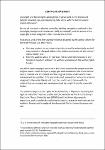Sofa-Surfing: The Cartographies of Young People Utilising Host-Dependent Shelter.
| dc.contributor.supervisor | Yarwood, Richard | |
| dc.contributor.author | Green, Kieran | |
| dc.contributor.other | Faculty of Science and Engineering | en_US |
| dc.date.accessioned | 2024-04-05T11:16:43Z | |
| dc.date.available | 2024-04-05T11:16:43Z | |
| dc.date.issued | 2024 | |
| dc.identifier | 10530382 | en_US |
| dc.identifier.uri | https://pearl.plymouth.ac.uk/handle/10026.1/22236 | |
| dc.description.abstract |
In 2016, 35% of UK young people (16-25 years) reported having sofa-surfed in the past. Past research highlights that spaces where people sofa-surfing stay are often tenuous, short-lived and worsen over time, reducing mental health, educational attainment, and the ability to find work (McLoughlin, 2013; Albanese et al., 2018). However, a study has not elucidated how young people’s preferences, identities, experiences, and access to support create highly varied sofa-surfing geographies and outcomes. This study examined young people's different geographical experiences and outcomes of sofa-surfing. Specifically, I outline key sofa-surfing experiences centred on uses of space, mobility, and identity (cartographies) and the flows between these cartographies across time. Finally, I theorised the motivational capacity of imagined futures (termed more-than-homeless future identities) to assist an exit from homelessness. Young people (n=41) who had sofa-surfed for three days or more in the last two years were contacted via gatekeepers and interviewed at homeless charities or via Zoom or telephone between September 2020 and August 2021. A two-stage thematic analysis was conducted on transcribed interview data in NVivo. The young people inhabited six cartographies: Seeking Home, Seeking Intimacy, Overstaying, Those Who Wander, Short-Term Sofa-Surfing, and finally, Exiting after Longer-Term Homelessness. There are five flows: Secure, Wandering-Intimacy, to Supported, Overstaying, Collapse to Supported, Secure to Secure, Holding Tightly to Home and an Uprooted Flow. In the main, these cartographies and flows captured experiences driven by young people's changing needs for independence or dependency combined with the availability of (un)caring hosts. The motivational capacity of young people's imagined futures also depended on experiencing past trauma. In conclusion, my cartographies, flows, and futures outline the different geographical experiences and outcomes of sofa-surfing by young people. I recommend implementing tailored support, seven-day sofa-surfing backup plans and sofa-surfing agreements. Future research should explore the experiences of hosts and older sofa-surfers and the relationship between sofa-surfing and attachment style. | en_US |
| dc.language.iso | en | |
| dc.publisher | University of Plymouth | |
| dc.rights | Attribution 3.0 United States | * |
| dc.rights.uri | http://creativecommons.org/licenses/by/3.0/us/ | * |
| dc.subject | Sofa-Surfing | en_US |
| dc.subject | Youth Homelessness | en_US |
| dc.subject | Cartographies | en_US |
| dc.subject | Pathways | en_US |
| dc.subject | Hidden Homelessness | en_US |
| dc.subject | Youth Transitions | en_US |
| dc.subject | Future Selves | en_US |
| dc.subject | Possible Selves | en_US |
| dc.subject | Third-Sector | en_US |
| dc.subject | Voluntary Sector | en_US |
| dc.subject | Homelessness | en_US |
| dc.subject | Housing | en_US |
| dc.subject | Careers | en_US |
| dc.subject | Pathways | en_US |
| dc.subject | Flows | en_US |
| dc.subject.classification | PhD | en_US |
| dc.title | Sofa-Surfing: The Cartographies of Young People Utilising Host-Dependent Shelter. | en_US |
| dc.type | Thesis | |
| plymouth.version | publishable | en_US |
| dc.identifier.doi | http://dx.doi.org/10.24382/5166 | |
| dc.rights.embargoperiod | No embargo | en_US |
| dc.type.qualification | Doctorate | en_US |
| rioxxterms.version | NA | |
| plymouth.orcid_id | https://orcid.org/0000-0002-3034-8329 | en_US |
Files in this item
This item appears in the following Collection(s)
-
01 Research Theses Main Collection
Research Theses Main



